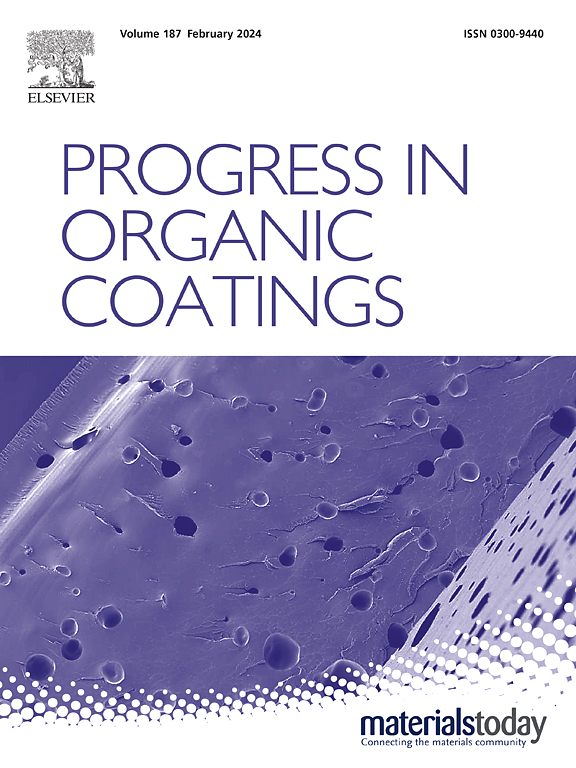用于自修复和防腐环氧涂料的高岭土负载NiCo-LDH纳米容器
IF 6.5
2区 材料科学
Q1 CHEMISTRY, APPLIED
引用次数: 0
摘要
由于经济和环境的原因,金属的腐蚀防护受到了广泛的关注。在现有的方法中,有机-无机涂层仍然是最实用和最经济的屏障技术。然而,传统配方经常存在耐久性有限、附着力不足和生产成本高的问题,这限制了它们在恶劣环境中的大规模部署。在本研究中,高岭土作为底物,水热共沉淀NiCo-LDH,得到K/NiCoLDH复合材料。然后将有机缓蚀剂没食子酸(GA)插入到NiCo-LDH结构中,形成K/NiCoLDH@GA纳米容器,并将其添加到环氧基中,以增强其耐腐蚀性和自修复能力。结构表征表明高岭土与NiCo-LDH有效结合,并证实GA嵌入到LDH夹层中。电化学测量和激光共聚焦显微镜显示,K/NiCoLDH@GA通过提供屏障保护和活性离子交换,有效地抑制了Q235钢的腐蚀。制备的K/NiCoLDH@GA/EP涂层在模拟海水环境中进行了长期电化学测试,显示出持续的防护性能。为了检测涂层的自修复行为,在涂层表面引入人工划痕,并通过扫描开尔文探针(SKP)监测修复过程。结果表明,从纳米容器中释放GA可显著降低缺陷部位的局部腐蚀。总的来说,K/NiCoLDH@GA纳米容器系统为在苛刻的海洋环境中设计坚固、环保、耐腐蚀的环氧涂料提供了一条有前途的、成本低廉的途径。本文章由计算机程序翻译,如有差异,请以英文原文为准。
Kaolin-supported NiCo-LDH nanocontainers for self-healing and anti-corrosion epoxy coatings
Considerable attention has been paid to the corrosion protection of metals due to economic and environmental issues. Among the available approaches, organic-inorganic coatings remain the most practical and economical barrier technology. Nevertheless, conventional formulations frequently suffer from limited durability, inadequate adhesion, and elevated production costs, which restrict their large-scale deployment in harsh environments. In this study, kaolin served as a substrate for the hydrothermal co-precipitation of NiCo-LDH, resulting in K/NiCoLDH composites. Gallic acid (GA), an organic corrosion inhibitor, was then intercalated into the NiCo-LDH structure to form K/NiCoLDH@GA nanocontainers, which were added to an epoxy matrix to enhance corrosion resistance and self-healing capabilities. Structural characterization demonstrated the effective combination of kaolin and NiCo-LDH, and confirmed GA intercalation into the LDH interlayers. Electrochemical measurements and laser confocal microscopy revealed that K/NiCoLDH@GA effectively inhibited the corrosion of Q235 steel by providing both barrier protection and active ion exchange.The prepared K/NiCoLDH@GA/EP coating was further evaluated through long-term electrochemical tests in a simulated seawater environment, showcasing sustained protective performance. To examine self-healing behavior, an artificial scratch was introduced on the coating surface, and the repair process was monitored via scanning Kelvin probe (SKP). Results indicated that the release of GA from the nanocontainers significantly reduced localized corrosion at the defect site. Overall, the K/NiCoLDH@GA nanocontainer system offers a promising, cost-conscious pathway for designing robust and eco-friendly corrosion-resistant epoxy coatings in demanding marine environments.
求助全文
通过发布文献求助,成功后即可免费获取论文全文。
去求助
来源期刊

Progress in Organic Coatings
工程技术-材料科学:膜
CiteScore
11.40
自引率
15.20%
发文量
577
审稿时长
48 days
期刊介绍:
The aim of this international journal is to analyse and publicise the progress and current state of knowledge in the field of organic coatings and related materials. The Editors and the Editorial Board members will solicit both review and research papers from academic and industrial scientists who are actively engaged in research and development or, in the case of review papers, have extensive experience in the subject to be reviewed. Unsolicited manuscripts will be accepted if they meet the journal''s requirements. The journal publishes papers dealing with such subjects as:
• Chemical, physical and technological properties of organic coatings and related materials
• Problems and methods of preparation, manufacture and application of these materials
• Performance, testing and analysis.
 求助内容:
求助内容: 应助结果提醒方式:
应助结果提醒方式:


